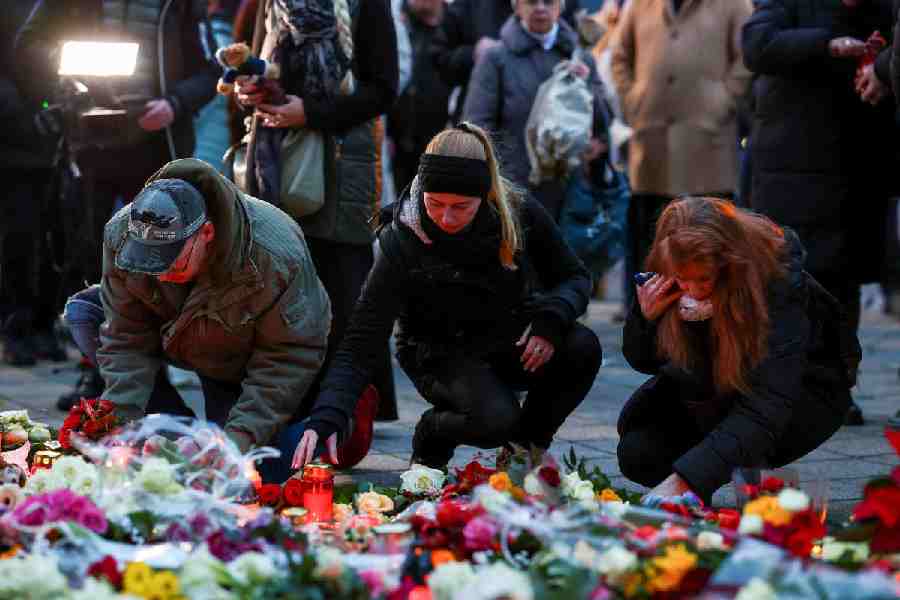 Monday, 23 December 2024
Monday, 23 December 2024
 Monday, 23 December 2024
Monday, 23 December 2024
On a clear day, Chile’s towering 5,400-meter El Plomo mountain can be seen from the capital, Santiago. The glacier-capped Andean peak has been climbed and revered for centuries, with the Incas carrying out human sacrifices at the summit.
The route to the top is still the same path paved by the Incas, with archeological remnants scattered along the way. An Incan mummy was found near the summit in 1954, perfectly preserved due to the mountain’s dry and cold conditions.
Now the mountain is crumbling. Rising global temperatures due to climate change have led the glacier to retreat and the permafrost to melt. New lagoons have formed and ruptured, landslides have injured climbers and massive sinkholes have opened up, breaking up the ancient path to the summit.
(A view shows the Iver glacier close to the El Plomo mountain summit, in the Andes mountain range, in the Santiago Metropolitan Region, Chile, April 4, 2024)
“Every year things are changing more. Every year there’s more sadness,” Francisco Gallardo, a 60-year-old muleteer who has worked on the mountain since he was 14, told Reuters at the Federacion base camp, about 1,300 meters below the summit.
Gallardo said his family has been working at El Plomo for generations, but he thinks they have about a decade left before they’re forced to move.
“We’re going have to go somewhere else, see what we can do, maybe head south,” he said.
(Gallardo loads mountaineering equipment belonging to mountain guide Luis Diaz (right), 44, as he leaves the mountain the day after ascending it, at the El Plomo mountain area, Chile, April 5, 2024)
Just a few years ago, the last push to the summit required a glacier traverse. Now, the final ascent is a rocky hillside.
Gallardo said mules used to be able to reach another camp about 500 meters further up, and he remembers mules feasting on grass around the base camp.
The Federacion camp was barren during a visit in April, with dirt and rock piling up near mountain faces that Gallardo said used to be covered with snow and ice.
“The changes we're seeing are unprecedented in recent human history,” said Pablo Wainstein, a civil engineer who has studied Andean and Arctic glaciers and permafrost for more than two decades.
(Mountain guide Daniela Pagli, 43, holds a piece of melted ice from the Iver glacier, Chile, April 4, 2024)
The Andes mountains present different types of frozen formations, including covered and uncovered glaciers as well as rock glaciers. The latter, composed of a mix of debris and ground ice, react more slowly to changes in climate than uncovered glaciers where the ice is exposed. At high altitudes, the mountains may also have a layer of permafrost, defined as ground with temperatures below freezing for more than two years. Where ice is present in permafrost, it may bond soil, gravel and sand together.
“If permafrost degrades, it's not ‘cementing’ anymore the ground and it leads to more rockfalls in mountainous terrain,” Wainstein said, adding that permafrost change is harder to study since it involves the thermal state of the ground and it’s not visible on the surface.
Glaciers in the Andes are also understudied compared to other regions due to how vast the range is and how remote many of the mountains are, Wainstein said.
(A drone view shows climbers ascending near a hole formed in a landslide area at the El Plomo mountain, Chile, April 5, 2024)
Among the best witnesses to these changes are the people who work on the mountain, climbing the same routes year after year, decade after decade. Reuters spoke to a dozen local guides and mountain rescue workers across three countries and trekked four mountains across the Andes to hear and see how conditions have transformed.
Osvaldo Segundo Villegas started working in mountain rescue in 1964 and participated in the rescue of the Uruguayan rugby team that inspired the Oscar-nominated film, Society of the Snow. Villegas, now 80, says his first ascent of El Plomo was in the 1960s, when a long glacier crossing was needed and the slopes were covered in beautiful 3-meter high ‘penitentes’ — thin blades of compact snow and ice oriented to the sun, formed as hard-packed snow melts in the dry, cold air of the high Andes.
(Villegas, a member of Socorro Andino, a volunteer organization that rescues people in mountain areas, holds an old picture of one of their first off-road rescue vehicles, at their headquarters’ warehouse, in Santiago, Chile, April 16, 2024)
Some hanging glaciers he used to climb are now just rock face. “When I am gone and you are gone, everything’s going to be lost,” Villegas said. “There were places in Patagonia I went to that were all glacier, now it’s forest. And that’s how it’s going to be.”
Wainstein said such changes are consistent with scientific predictions. The Andes mountain range is the longest in the world and has some of the fastest-disappearing ice packs. Venezuela was the first country to lose its last glacier this past May.
The Andes are home to approximately 99% of the world's tropical glaciers, which are more susceptible to climate change because they're consistently near or at freezing point. Data from the U.S. National Oceanic and Atmospheric Administration (NOAA) shows global temperatures have increased 0.06 Celsius (0.11 degrees Fahrenheit) per decade since 1850, accelerating to 0.20 C (0.36 F) per decade since 1982.
(Mountain guides Luis Diaz, 44, and Daniela Pagli, 43, along with Reuters journalist Alexander Villegas, walk along a path on their way to the El Plomo mountain summit, Chile, April 4, 2024)
The Andes are an essential part of the region’s water cycle. The mountains store water as snow and ice during the winter and slowly melt out during warmer months. They supply millions across the region with water, not only for drinking but also for agriculture, hydroelectricity and mining.
Glacial retreat has led to acidic rocks being exposed for the first time in centuries, leading meltwater to acidify and get contaminated with heavy metals that then leach into other water supplies as the region already faces dwindling water supplies.
Erratic and heavy rainfall has degraded the ecosystems, making them more susceptible to erosion, landslides and severe floods.
Rain in Peru
(Ice is seen on the Pastoruri glacier in the Peruvian Andes, Peru, May 7, 2024)
Temperatures are rising faster at higher altitude, with one multinational study published in the International Journal of Applied Earth Observation and Geoinformation showing that daytime winter surface temperatures in the Andes rose by 0.50 C (0.9 F) per decade since 2000 at an elevation of 1,000 to 1,500 meters, but by 1.7 C (3.06 F) above 5,000 meters.
Octavio Salazar made his first ascent of the season of Peru’s Yanapaccha mountain in early May. “It shouldn't be raining,” he said at base camp. At this time of year, rains would normally have passed; and at an altitude of 5,000 meters, any precipitation should be snow.
Salazar and his brother, Eloy, are indigenous Quechua brothers who have spent decades climbing mountains in Peru’s Cordillera Blanca, the largest glacier-covered area in the tropics and home to multiple 6,000-meter peaks, including the country’s tallest mountain.
(A view of the lagoons formed by the deglaciation of Mateo mountain in the Peruvian Andes, Peru, May 8, 2024)
The brothers started an expedition agency in 2010. One of their first activities of this season was this ice climbing class and expedition to Yanapaccha’s 5,460-meter summit. When they passed a rocky hill to start the ice climb, they saw the glacier had retreated several meters compared to last season. Now a further descent down unstable rocky moraine was needed to reach the glacier, black from dirt, pollution and a lack of new snowfall.
The nighttime glacier traverse required jumping over crevasses, straddling thin ice crossings and quickly crossing areas at risk of rockfall. The summit, known for some of the best views in the Cordillera Blanca, was shrouded by gray, freezing rain that formed a layer of ice around everything it touched.
“We feel like the climate has had such drastic changes that they often put everything you knew in doubt,” said Edson Ramirez, a park ranger and risk assessor for the Huascaran National Park, which comprises 90% of the Cordillera Blanca.
(Ice caps melt on the Nevado Pastoruri mountain, in the Peruvian Andes, Peru, May 7, 2024)
“Having rain drops at 5,000 meters isn’t common or natural. It’s an indicator that pressure, temperature are completely altered,” Ramirez said.
Rain also means that there’s no new snowpack to replace glacier mass as it slowly moves down the mountain.
“When there’s no more glacier to cover up crevasses, it becomes a difficult maze,” Ramirez said.
(A mountain guide checks the climbing harnesses of tourists before climbing Mateo, Peru, May 8, 2024)
It’s not just changes in climate that have fueled more accidents; there’s also been a surge in visitors, many with limited experience, says Ramirez.
But even experienced guides are in danger. Last year, Edgar Huaman was crossing an area on Huascaran, Peru’s tallest mountain. He was leading two French clients, when an ice bridge collapsed, killing him.
“He was one of the best guides, really strong,” said Rusbel Vidal, who got his certification alongside Huaman.
(Ice caps melt on the Nevado Pastoruri mountain in the Peruvian Andes, Peru, May 7, 2024)
It’s not just changes in climate that have fueled more accidents; there’s also been a surge in visitors, many with limited experience, says Ramirez.
But even experienced guides are in danger. Last year, Edgar Huaman was crossing an area on Huascaran, Peru’s tallest mountain. He was leading two French clients, when an ice bridge collapsed, killing him.
“He was one of the best guides, really strong,” said Rusbel Vidal, who got his certification alongside Huaman.
(Tourists ride on horseback to the Nevado Pastoruri mountain, in the Peruvian Andes, Peru, May 7, 2024)
The shifting climate is also affecting where and how winter sports are carried out. Peru’s Pastoruri glacier used to host ski competitions. Now it’s a glacier in extinction, with the remaining ice field cordoned off because of the risk of ice fall.
“Anything humans do has some level of risk, but we’re not going to stop enjoying our mountains because of that,” said Cristian Ramirez, the head of Chile’s mountain rescue unit in Santiago.
“The Andes are the backbone of this territory,” he said. “In some way they modulate our life because they collect ice, they collect water and we use that water to live. So mountains are life and we’re privileged to have this mountain range here.”







